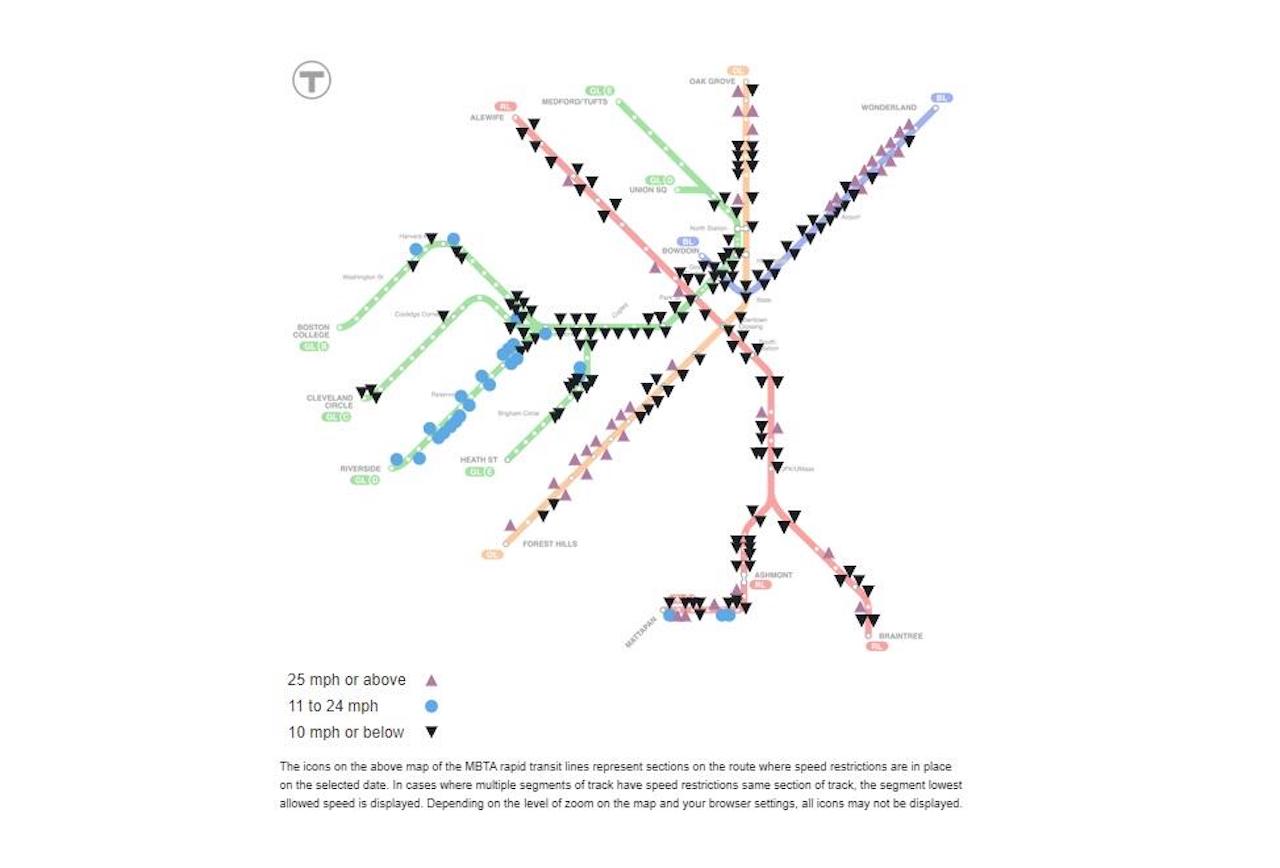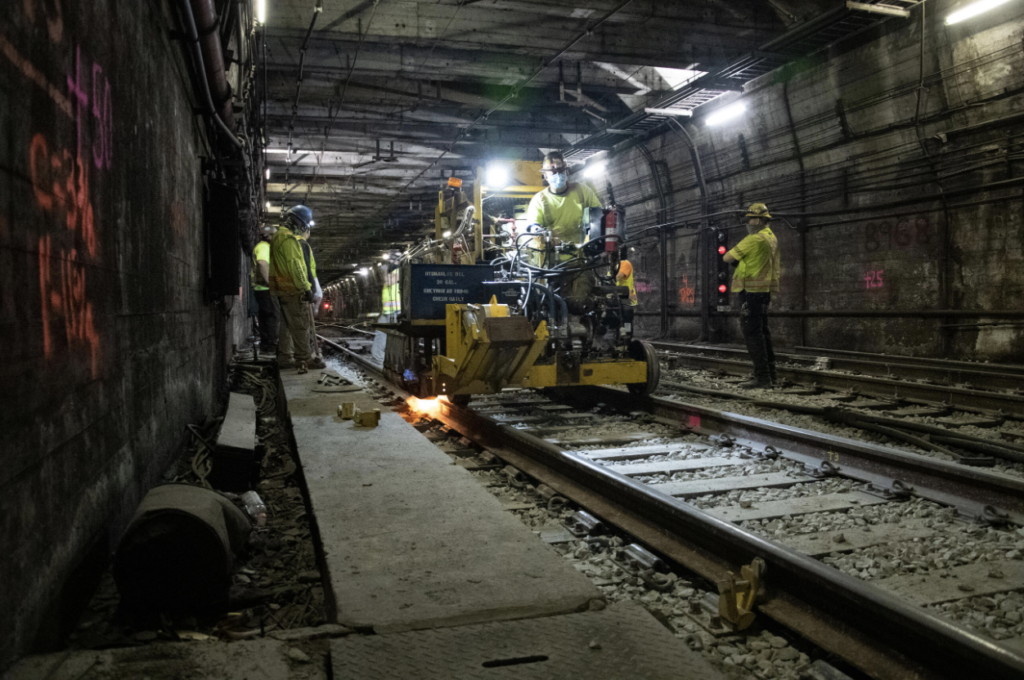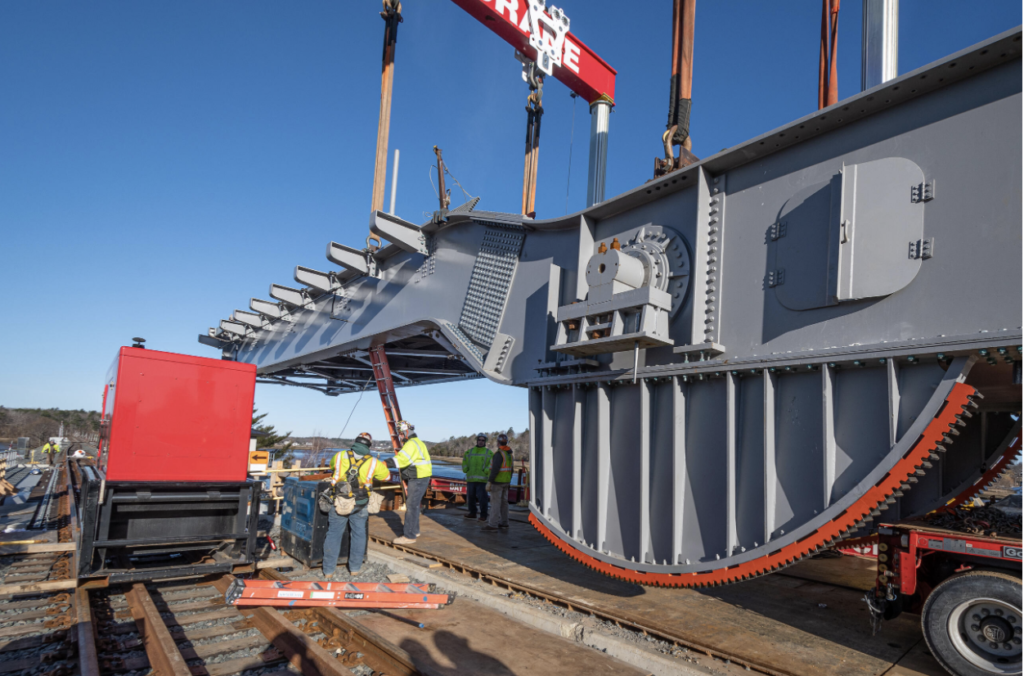
Transit Briefs: MBTA, SEPTA, TTC, VIA Rail, NJ Transit, BART, PANYNJ
Written by Carolina Worrell, Senior Editor
The MBTA has launched a Speed Restrictions Dashboard that will provide riders with up-to-date information on speed restrictions across the agency's system. (Image Courtesy of MBTA)
The Massachusetts Bay Transportation Authority (MBTA) launches online Speed Restrictions Dashboard; awards contract for major track and signal upgrades at South Station; and invites public comment on the proposed Capital Investment Plan (CIP) for Fiscal Years 2024-2028. Also, the Southeastern Pennsylvania Transportation Authority (SEPTA) awards design contract for Broad Street Line ADA Improvement project and approves proposal to install new fare gates; the Toronto Transit Commission (TTC) formerly ends token sales; VIA Rail Canada (VIA Rail) improves diversity and inclusion policies; NJ Transit advances improvements at Mahwah Station; Bay Area Rapid Transit (BART) moves forward with purchase of fare gates to be installed systemwide; and the Port Authority of New York and New Jersey (PANYNJ) advances plan to replace AirTrain Newark with selection of three firms as part of multi-phase procurement process.
MBTA
The MBTA on March 23 launched a live, online Speed Restriction Dashboard that provides riders with up-to-date information on speed restrictions across the agency’s system.
According to the MBTA, the dashboard reports on location, speed limit, when a restriction was put in place, and the reason for the restriction on the Red, Orange, Blue, Mattapan, and Green lines. The dashboard, which also provides the percentage of track under restriction, distance by individual line or systemwide, and total number of restrictions can be viewed here.

The dashboard, which follows last month’s launch of an online safety dashboard that allows the public to see the status of the T’s progress in responding to the Federal Transit Administration’s (FTA) Safety Management Inspection (SMI) Special Directives, is refreshed daily with data provided by the MBTA’s enterprise asset management system and helps riders see where speed restrictions are located with maps they are accustomed to seeing. The speed restriction activity summary, the agency says, will “help illustrate the ongoing work the MBTA is doing to clear restrictions within the system.” Last month, the MBTA began to provide riders with speed restriction data by releasing a static dashboard that reported information from the previous month.
Users of the dashboard will be able to see when speed restrictions were put in place starting from January 2023 and review a summary of changes over time. “This dashboard will provide riders with the latest information available at the start of each day providing a new level of transparency,” MBTA said.
This dashboard includes a description of each Corrective Action Plan, what it is intended to correct, the MBTA’s analysis, recommendations, and the status of steps being taken to address the FTA’s Special Directives.
Additionally, the MBTA Board of Directors on March 23 awarded a construction contract to Middlesex Corporation of more than $98 million to upgrade the tracks, switches and signals at South Station, which, the agency says, “will result in improvements to the reliability and resiliency of Commuter Rail and Amtrak train service into and out of the station.”
The contract will be funded through a combination of sources, including $41.2 million of a Federal Railroad Administration (FRA) State of Good Repair Grant, as well as additional funds from the MBTA and Amtrak.
According to the MBTA, the project, which is expected to begin in April and reach substantial completion in late 2027 with final completion anticipated in spring 2028, will “provide better operational reliability to the MBTA’s nine Commuter Rail lines that terminate at South Station, as well as Amtrak’s Northeast Corridor (NEC) and Lake Shore Limited services while also improving safety, resiliency, and security.”
When complete, the project at South Station will “address immediate state-of-good-repair needs of current train service while also supporting future growth of both the MBTA and Amtrak through numerous upgrades to track, signals, communications, and interlocking infrastructure,” the agency said. In addition to track and signal work, this project includes installation of a new master signal house, a new backup generator, inverter, and transformer system; switch heaters as well as electrical and signal cable trough systems; new LED lighting of the track and overhead wire areas; and provide new security systems, including cameras and fencing.

Separately, the MBTA on March 23 released the proposed FY24-28 CIP for public comment, marking the beginning of a 30-day public comment period.
The CIP is a five-year financial plan that funds all the MBTA’s capital projects, which are “investments or activities related to acquiring, constructing, improving, or maintaining a capital asset, including planning and design.”
According to the MBTA, the CIP is updated annually to ensure the agency is continuing to:
- “Advance key safety projects that are instrumental to reducing safety risks, increasing system reliability, lowering maintenance costs and improving system performance.
- “Improve the reliability of the MBTA’s transit system and modernize existing assets to accommodate current or anticipated growth.
- “Make targeted investments in the expansion of the transportation network to increase capacity or provide riders with more options across transit modes.”
The proposed FY24-28 MBTA CIP (available here) includes 600 unique capital projects to modernize, expand, and increase the safety and reliability of the MBTA transit network.
The CIP document includes an overview of the Authority’s capital planning process, summaries of investment programs, and the full list of capital projects in the proposed five-year CIP.
The MBTA encourages members of the public to provide input on the proposed FY24-28 CIP before April 24, 2023, and will host two virtual public meetings (March 30 at 6:30 PM; April 12 at 6:30 PM) and one in-person public meeting (April 4 at 6:3- PM) to provide an overview of the proposed FY24-28 CIP and invite attendees to share their feedback.
Members of the public who are unable to attend a public meeting are invited to provide public comments by completing the online CIP comment form, sending an email to [email protected] or mailing a letter to MBTA CIP c/o MBTA General Manager at 10 Park Plaza, Suite 3830, Boston, MA, 02116.
SEPTA
SEPTA on March 23 awarded a contract to Jacobs Engineering Group, Inc. (Jacobs) to advance accessibility improvements on three subway stations. Jacobs will perform architectural, design and construction-related services for the Lombard-South and Ellsworth-Federal Station on the Broad Street Line, and the Chinatown Station on the Broad-Ridge Spur.
These stations, according to SEPTA, were built decades before the enactment of the ADA and are currently only accessible via stairs but thanks, in part, to federal infrastructure funding, the agency says it is “committed to making all stations on the Broad Street Line and Market-Frankford Line accessible.
The $5,793,063 contract with Jacobs will progress the design of Lombard-South, Ellsworth-Federal, and Chinatown Stations to 100%. Once design is completed, SEPTA says it can then advance on the construction phase. Improvements that will make these stations fully ADA accessible and in a state of good repair include elevator installation; platform renovation; new signage, lighting, and security cameras; and waterproofing.
SEPTA has prioritized accessibility on both the Market-Frankford Line and Broad Street Line in its 12-Year Capital Program. In addition to the three Broad Street Line stations that will advance with March 23 Board approval, SEPTA says it is close to completing an ADA improvement project at Susquehanna-Dauphin Station, and construction is under way at Tasker-Morris Station. SEPTA will also update the timelines for work at other stations on the Broad Street and Market-Frankford Lines with the release of the new capital budget and program in April.
Additionally, SEPTA’s Board on March 23 approved a proposal to install new fare gates to “discourage people from riding the trains,” according to a CBS News report.
According to the report, SEPTA will test full-size gates, which the agency says will “deter people from jumping over them to avoid paying their fares” on the Market-Frankford Line, at the 13th Street and 34th Street stations.
“Would-be fare evaders could not jump over or crawl under the gates, and an alarm would go off if someone tries to run through after someone in front of them pays a fare,” a SEPTA spokesperson told CBS News.
The gates would be installed by early 2024.
TTC
March 24 is the last day that tokens can be purchased from any location where fares are sold, TTC reported March 23.
While tokens have not been sold directly by TTC since December 2019, they have been available at select third party retailers. But with the modernization of TTC’s fare purchasing system, the agency says most customers have already made the switch to PRESTO, which makes up for more than 90% of TTC ridership.
According to TTC, customers can continue to use previously purchased TTC tokens or tickets to pay their fare, which is the same price as using PRESTO.
VIA Rail
VIA Rail and the National Council of Canadian Muslims (NCCM) met on March 22 and “engaged in a constructive dialogue” following “the regrettable and saddening incident” involving a man who was praying in VIA Rail’s Ottawa Station.
According to a CTV News report, VIA Rail is working to improve its diversity and inclusion policies after a Muslim man, who after praying in an empty hallway at the train station, was told by a security guard not to pray.
VIA Rail’s conversation with NCCM focused on common objectives, namely, to “ensure that VIA Rail provides an inclusive environment where passengers and employees feel safe practicing freedom of religion, including the ability to worship,” the corporation said in a release.
According to the release, VIA Rail representatives “reiterated the corporation’s apologies for the event to the entire Muslim community” and “reaffirmed that VIA Rail strongly condemns Islamophobia, as well as any form of discriminatory behavior.”
NCCM has also been in contact with the individual involved in the incident and is committed to working with all partners to “ensure that together we build a Canada free from Islamophobia,” VIA Rail said.
“VIA Rail is grateful to be able to count on the guidance and support of NCMM to improve its passenger and employee experience and is looking forward to cultivating a fruitful collaboration with them,” the corporation stated.
NJ Transit
NJ Transit on March 23 announced that it is moving forward with plans to revitalize Mahwah Station by releasing an invitation to bid for critical state of good repair work to the station’s roof, replacement of retaining walls and electrical and lighting upgrades to “enhance the customer experience.” These improvements, the agency says, will “preserve the building’s historic aesthetic while also enhancing a central piece of Mahwah Township’s downtown.”
As part of the procurement process, NJ Transit’s Invitation for Bid includes the following:
- Roof repairs to include new framing, gutters, downspouts, roof sheathing replacement and rafter repair and replacement.
- Retaining wall and site work to include replacement of a retaining wall, including north stairs, concrete work and associated landscaping.
- Electrical work to include re-location of the ticket vending machine and electrical equipment and lighting upgrades below the roof ceiling over the arcade columns.
BART
BART announced March 23 that it is moving forward with the purchase of brand-new fare gates to be installed systemwide as part of its latest effort to “win riders back and overhaul safety in the system.”
The new fare gates, BART says, will bring a new look and improved experience, offering state-of-the-art technology that will “boost safety by reducing fare evasion, enhancing access for people in wheelchairs and those who bring bikes and strollers on BART, and optimizing the reliability and maintenance needs of the fare gates.”
At a March 23 Board of Directors meeting, BART staff recommended the Board move forward with the first purchase of the $90 million Next Generation Fare Gate project, which calls for all stations to have new fare gates by 2026, and recommended awarding up to $47 million to STraffic America, LLC (STraffic) to implement the project. According to the agency, BART staff will develop an installation timeline with STraffic and will stress-test the new fare gate design at a yet-to-be-determined station later this year.
According to BART, the new design has not yet been finalized but will “look unlike any other of the current 700 fare gates” in the agency’s system. They will also be different than the new swing-style fare gates designed by BART staff and recently installed to enclose elevators into the paid area.
The new gates, BART says, will be able to handle large crowds without slowing people down as they move in and out of stations while processing their Clipper cards; include advanced 3D sensors that are able to detect if someone is in a wheelchair or has a bike, stroller, or luggage with them, allowing for more time before the swing barrier closes; and include LED lighting on the swing barriers and the pathway through the gate to help visually impaired riders. According to the agency, STraffic has “worked extensively with members of the ADA community and is committed to continue this work while designing the BART gates.”
To date, BART has secured $73 million of the $90 million project, with funding from:
- BART Funds (Operating-to-Capital Allocations and Measure RR) $23M
- County Transportation Agency Funds $28M
- Federal Funds $15M
- State Funds $6.5M
In recommending the vendor, BART staff evaluated proposals from industry leaders and scored each proposal on their technical approach, qualifications, experience in delivering similar projects, and price. STraffic, the agency says, offered the best value to BART and committed to subcontracting 11% of the work to Disadvantage Business Enterprises (DBE).
PANYNJ
PANYNJ on March 23 announced that it has selected three automated-people-mover (APM) system technology firms to advance to the next phase of a multi-phase procurement process to replace the existing AirTrain Newark system at Newark Liberty International Airport (EWR) with a new 2.5-mile automated train system.
The three shortlisted firms, which were selected because of a publicly advertised Request for Qualifications (RFQ) that was published on Dec. 8, 2022, are Alstom Transport USA Inc., DCCCA1 Inc. (Doppelmayr) and Mitsubishi Heavy Industries America Inc.
As part of the PANYNJ’s “ongoing commitment to modernizing Newark Liberty International Airport,” the agency says AirTrain Newark will be replaced through a multi-phase procurement process, including the design and construction of the new AirTrain’s APM system technology, and the operations and maintenance of the components necessary for a new fully functional, world-class AirTrain. Also included in this first phase are the procurement processes for the furnishing, delivery, installation, testing and commissioning of the system technology.
Additional procurement phases in the AirTrain Newark Replacement program may include, but are not limited to, the following separate contract packages:
- Early works packages.
- Design package.
- 2.5-mile elevated guideway structure and three stations, including back-of-house areas
- Maintenance and control facility for the system technology equipment.
- Pedestrian connections from stations to existing airport facilities.
For the APM system technology opportunity, PANYNJ says it will be conducting a virtual Minority/Woman Owned Business Enterprise (M/WBE), Service-Disabled Veteran-Owned Business (SDVOB), and Local Business Enterprise (LBE) Industry Outreach Forum for the AirTrain Newark Replacement program–system technology project on Thursday, March 30, 2023. Interested attendees can register here.
“The Port Authority’s airports are the gateways to the world and play a significant role in the region’s economy,” said PANYNJ Chairman Kevin O’Toole. “As air travel demands continue to grow, this agency is committed to making necessary investments, including spending billions of dollars to modernize our airports and their transportation assets like the AirTrain.”
“The AirTrain is a critical part of Newark Liberty’s operations, and the existing system is nearing the end of its useful life,” said PANYNJ Executive Director Rick Cotton. “It is imperative to build a new 21st century AirTrain to serve the new world-class terminals that we are building at Newark Liberty.”
Debuted in 1996, the existing AirTrain Newark system, which carries an average of 26,000 passengers per day or nearly 10 million passenger per year, has become “outmoded and unreliable,” PANYNJ said. It provides access to the co-located Newark International Airport station on NJ Transit and Amtrak’s NEC lines and provides customers and employees with the ability to transfer among airport terminals, parking lots and rental car facilities. The Federal Aviation Administration (FAA) granted final environmental approval for a replacement of AirTrain Newark on Aug. 13, 2021.



